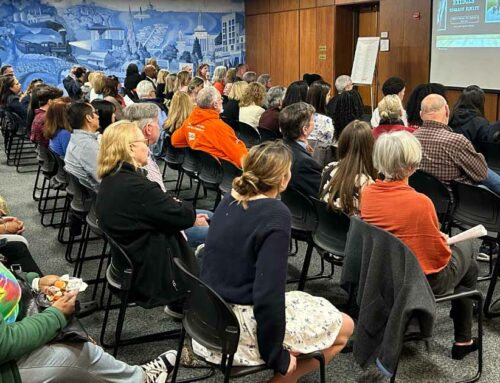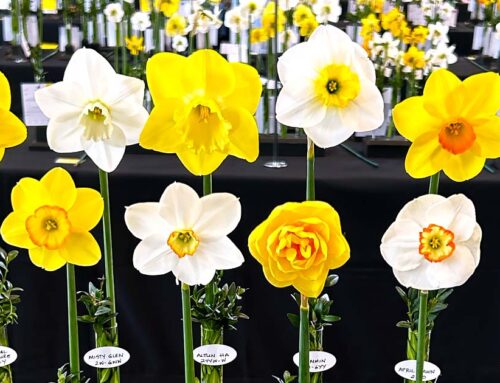
“A work of art which did not begin in emotion is not art.” — Paul Cezanne.
There’s a very good chance you’ve seen local artist James Chillington set up with his easel painting along Greenwich Avenue.
Often working on large canvases, Chillington layers paint thickly with his palette knife. A kaleidoscope of bright colors furiously converge and eventually conspire to convey the impression of a place, and some of its people, and some of its moments, and some of its light, and so much more.
Chillington’s award-winning paintings have been exhibited at venues throughout Connecticut, including The Virginia Barrett Gallery (Greenwich, CT), Silvermine Guild Arts Center (New Canaan, CT) and Rowayton Arts Center (Rowayton, CT), Darien Art & Frame (Darien, CT), Darien Historical Society (Darien, CT), and America’s Best Auctioneer, Inc. (Stamford, CT).
Chillington has studied art at the University of Connecticut, Silvermine School of Art (New Canaan, CT) and the Carving Studio (West Rutland, VT). His work has been included in several public and private collections, and he was included in the 16th Shanghai Art Fair in 2012.
“When I set out to create a plein air painting,” states Chillington, “I decide upon a location, set up my paints, quiet my mind, and commune with my surroundings. All the while my energy becomes more focused. I begin a spontaneous sketch, allowing my intuition to take over. I continue to make marks based on what I observe as well as what I feel. I compensate for the shifts in sunlight, the movement of leaves, the spread of shadows and other countless changes that occur naturally in a scene. When I finish, I know my painting is complete when my canvas and the scene I’ve painted convey the same feeling of balance and mood.”
The “balance and mood” is always present on Chillington’s finished works – but there is also something that resonates a little more meaningfully. There’s emotion, passion, and deep feelings mixed with the paint on many of Chillington’s canvases, as well.
Living Greenwich’s contributing arts writer, Eric Taubert, decided he wanted to learn more about the artist behind these plein air paintings and his process – so he recently caught up with Chillington for a conversation – which you can read below.
But first, take a moment to acquaint yourself with the artist’s work through this photo gallery featuring a variety of Greenwich-themed paintings by Chillington.
Photo Gallery: Paintings By James Chillington
A Conversation With Artist James Chillington:
Thanks for talking with me today, James. Why don’t we begin with you telling me a little about how you ended up living a life in the arts?
I think growing up in a house with a mom that painted along with Bob Ross, and was always creative with many different crafts, certainly sparked an interest in my creative drive and general work ethic. I think I am most well-known as a plein air painter. I find adventure in setting out with a blank canvas, and custom boxes, and painting supplies packed in a bag in search of feeling, a chance to feel more about the land, a thing, a gust of wind, self-doubt, lust, fear, respect, and on and on. There’s no easy way to describe the feeling when you’re chasing emotions, I guess.
It sounds like you’re very passionate about painting, and there’s something pretty deep motivating you to do the work. Can you talk more about how “emotions” are tied into the work you’re doing?
I can’t think of any other activity that allows a person to feel such a wide range of strong emotions, as when they’re making marks on canvas. For example, just finding a scene and getting to a place that’s new to you; when you do that, there’s emotions. Sometimes there’s the physical strength needed to carry yourself and the supplies, or there’s a need for ingenuity — and once you’ve arrived in that special place that speaks to you, you try to empty your thoughts, take in the scene before you, and just let your subconscious mind (or heart) get to know what’s out there. There’s a lot to feel when things are going right — and maybe even more to feel when things are not going the way you hoped they would. For me, sketching and painting offers a chance to feel instantly good, bad, or in-between with just the swipe of your arm. Knowing this, and when its ingrained, it calls to you. And that call becomes something you stop hearing and start feeling. It becomes a force that balances. It takes you to extremes when you want it to.
I’m a street photographer who also happens to be friends with many plein air painters — and when we get to talking, we discover there are a lot of similarities when it comes to our processes, because we are all working from life. The plein air process is so different from studio work. There’s an immediacy to it. There’s an unpredictability to it. One of my good friends, artist Mary Byrom, told me a story once about painting a plein air landscape which included a large tree — and, halfway through the painting, someone unexpectedly showed up and chopped down the tree. You never know what you’re going to encounter out there – or what changes might quickly pop up in any scene you’ve chosen to paint. Have you developed any strategies to address the unique challenges of painting outdoors, and painting from life?
Definitely. I’m developing new ways and means to get out there and follow my interests, including arranging a special lightweight art box to fit my unique needs. When I’m painting from life, my needs evolve rapidly, because my interests are constantly evolving, too.
Let’s switch things up a little bit. Has the time you’ve spent creating art taught you any important lessons in your life?
Yes. Empathy! Just before Christmas 2012, I prayed to god that I could feel more for the tragedy that happened in Newtown, where I had been living in for 4-5 years. Many people in my life got together one day in support for the Newtown school shooting victims and the emotions were too strong for most of us to hold back the tears. I thought I was having a problem, so I turned towards art as a way to relate. I found a setting in Stamford of two pools of water surrounded by trees — and the larger pool was flowing into the small one. My interpretation was 2 pools of knowledge; the larger (teachers) flowing to the smaller (students). The larger pool was surrounded by 20 trees, and the smaller by 6 reflections of trees; in my mind, this symbolized the 20 children and the 6 educators involved in the tragedy. I parked my car and walked over to the larger pond, where I saw a waist-high wooden stake in the ground beside the pond. The stake had a small brass tag on it marked with “20 – Memorial Walk” — and I immediately knew I was in the right place. I set up my easel and started to sketch and paint, with the intent of breaking through, but nothing different happened. I completed the painting in a few sessions. Unsuccessful with my first go at it, I thought I’d try another. So I set up the easel and sketched the scene, and again — no connections to what I was looking for. The next day, I came back to the scene. Before I started painting, I sat there a little while longer thinking about what had happened at the elementary school that day — and then something powerful came over me. I started to visualize what actually took place during the tragedy — and the terror of it hit me in a hard way. After about 15 minutes of bawling, with tears streaming down my face, I went out and painted the same scene again. This time, feeling more compassion than I ever could before — and it was then and there that I felt the raw power of emotion, and how that emotion can work its way through your body. It showed me how I can be in front of something — a tree, flower, human, urban street scene, anything — and tap into the passion and uniqueness of that experience, and channel it all through communication mark-making, whether it’s drawing or painting. It’s unlike anything else I can think of, and when it happens it’s truly magical.

You paint quite often in Greenwich, CT. Tell me, how has this town had an impact on your art?
I’ve made my living as a roofing contractor for the last 35 years in the area — and I’ve visited inside many homes to check on roof problems. I always knew when I was called out to a Greenwich home, that there was a higher likelihood I was going to see some amazing artwork on the walls of the house I was working in. As time went on, I became more interested in art — and I’d spend time in bookstores and libraries looking at examples of master artworks, until I got passionate enough that I was driven to visit the Metropolitan Museum in NYC to see Van Gogh’s “Irises”. It was one of the most impactful art experiences I’ve ever had.
If you could go back to the beginning of your journey as an artist – what is the one piece of advice you’d give your former self?
Figure drawing from life is key for an artist to gain a relationship between the hand and the heart, practice this for at least 2 hours 3 times a week.
Let’s talk about other artists, for a minute. Who else is doing work that you like these days?
Matt Talbert’s portrait and figure paintings amaze me! I like the abstraction, texture, composition and feel of his works.
Thanks for everything today, James. Before we wrap this up, can you tell my readers where they can we see (and/or buy) more of your work?
I’ve been painting plein air in Greenwich and selling the pieces right off the easel to passersby. I also show work on the walls of Coffee Café Roasters at 118 Greenwich Ave, Greenwich, CT
Learn More About James Chillington: https://www.jimchillington.com/

















